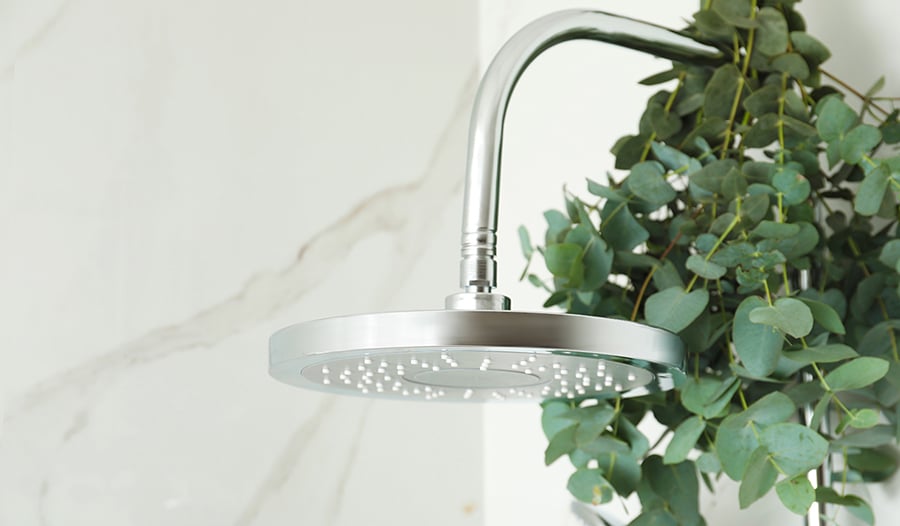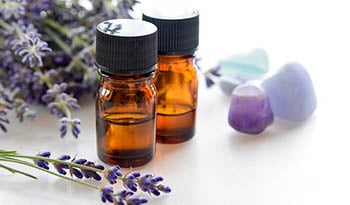在淋浴间悬挂桉属植物的3大原因
免责声明:本博客不提供诊断⋯
- 本文內容:
- 桉树油有什么功用?
- 桉树油和呼吸系统疾病
- 桉树油的抵御细菌作用
- 驱虫剂
- 安心性
- 要点

桉树油有什么功用?
桉樹精油 历史上用于治理肺部疾病,也因為它的抵御细菌功效而被用于古老療法。桉树油是利用蒸汽蒸馏方法从桉树叶中提取出来的油。这种油与桉树叶相似,具有浓烈、清新的独特香味。桉树精油可以从不同的桉树品种提取,每种都具有不同的效果。
大多数桉树油的主要成分是桉叶油醇(1,8-桉树脑),水平从45-77%不等,甚至含量可能更高。桉树精油通常用于草本软膏,以治理胸部和鼻窦充血。正如许多民间疗法,特新研究开始支持桉树油的历史用途。
桉树油和呼吸系统疾病
提起 桉树油,大多数人可能会联想到吸入这种油来帮助缓解鼻窦和胸部充血。桉树油的主要成分桉叶油醇具有溶解粘液特性。简单来说,它有助于减少粘液。研究显示,桉叶油醇可显著降低参与粘液产生的两种基因的表现。
除了粘液溶解作用,桉叶油醇还有助于松弛呼吸道的平滑肌。这可以帮助肺部扩张,减少充血,使呼吸更容易。除此之外,桉树油还展示出强大的缓解炎症活性,进一步彰显它对呼吸系统疾病的益处。大多数关于桉树油对呼吸益处的研究,都是使用口服胶囊形式的纯桉叶油醇。
桉树油的抵御细菌作用
桉树具有众所周知的抵御细菌作用,尽管在各桉树物种之间也存有显著差异。在某些情况下,桉树油已被证明可有效杀死真菌、细菌和寄生虫,并具有潜在的抗病毒作用。
真菌
与标准抗真菌药品相比,桉树精油对口腔中的念珠菌具有相似的作用。研究的作者基于有关结果而得出结论,指稀释的桉树油可能有助于保持口腔卫生。多年来,桉树一直是几种不同的 天然漱口水产品的常见成分。
细菌
由于细菌抑制剂的过度使用,细菌对标准抵御细菌修复的机体防御力越来越强。好几种细菌以其耐药性而闻名,包括金黄色葡萄球菌和结核分枝杆菌。特近的一项研究发现,桉树精油对大多数抗药性金黄葡萄球菌(MRSA)的菌株具有令人满意的效果。其他研究也得出类似的结果。
全世界约有四分之一的人口感染了导致结核病的细菌。这些人中的一部分会患上结核病。这是一种可能致命的肺部感染。结核病是由分枝杆菌感染所引起,包括结核分枝杆菌。一项研究发现,桉树精油是一种颇有前景的潜在治理方法,可在1%的稀释度下,完全控制具有多重抗药性的分枝杆菌的生长。
寄生虫
棘球绦虫是一种寄生于动物体内的绦虫,可以感染人类。在一项对绵羊绦虫幼虫的研究中,1%浓度的桉树溶液可在一分钟内杀死100%的幼虫,效果与标准药品聚维酮碘和硝酸银相似。
头虱是另一种在儿童中常见的寄生虫感染。标准治理方法采用神经毒性杀虫剂氯菊酯,尽管数据显示桉树油也可能是一种选项。虱卵暴露于10%桉树油5分钟后被有效杀死。虱卵暴露于氯菊酯10分钟后,仍有95%的孵化率。 生姜 精油 也显示出类似的结果。研究发现,当它们与桉树联合使用时效果更佳。
驱虫剂
某些桉树品种,尤其是柠檬桉树,作为 天然驱虫剂时显示出具有令人满意的效果。柠檬桉树精油具有明显的柠檬味。即使环境保护局的有效驱虫剂清单中,也包括柠檬桉油在內。与普通桉树不同,柠檬桉树富含一种名为香茅醛的化合物。
一些研究专门针对具驱虫剂功效的天然化合物 ,当中包括若干常见的 精油成分,如柠檬烯、桉叶油醇、香叶醇、丁香酚和香茅醛。柠檬烯存在于柑橘类精油中,如 橙子、 柠檬和 青檸。桉叶油醇存在于桉树油之中。香叶醇存在于玫瑰油、玫瑰草油和 香茅油之中。丁香酚主要来自 丁香精油。至于香茅醛则存在于柠檬桉和香茅精油之中。以精油组合作为防止虫子的自然方法似乎颇有功效。
桉树油确实会吸引一些会蜇人的兰花蜜蜂,尽管这些兰花蜜蜂仅在南美洲和中美洲生长。不过,兰花蜜蜂被认为较一般蜜蜂安心,而且不会在中南美洲以外的地方出没。
安心性
许多探索 桉树精油 效果的研究,皆使用口服形式的纯化桉叶油醇。精油含有高效的天然化学物质,但搀杂的情况在某些商业产品中并不鲜见。近期的估计显示,多达80%的市售精油可能存有某种方式的搀杂。
必须在具有专业知识的医学健康提供者的建议下,方可尝试口服精油,以确保安心性和适当的剂量。对于药学使用精油,以独立的实验室分析确认产品的纯度也很重要。
要点
对 桉树精油 及其成分进行的研究,显示出其具有令人满意的活性,有助于缓解呼吸系统疾病。桉树似乎还对多种生物体有抵御细菌作用(包括某些细菌、真菌和寄生虫)和抗病毒作用。使用精油作为驱虫剂的配方也显示出成效,特别是柠檬桉树精油。
参考文献:
- Aldoghaim FS, Flematti GR, Hammer KA. Antimicrobial Activity of Several Cineole-Rich Western Australian Eucalyptus Essential Oils. Microorganisms. 2018;6(4):122. Published 2018 Dec 3. doi:10.3390/microorganisms6040122
- Tyagi AK, Malik A. Antimicrobial Potential and Chemical Composition of Eucalyptus globulus Oil in Liquid and Vapour Phase Against Food Spoilage Organisms. Food Chem. 2011;126(1):228-235.
- Sudhoff H, Klenke C, Greiner JF, et al. 1,8-Cineol Reduces Mucus-Production in a Novel Human Ex Vivo Model of Late Rhinosinusitis. PLoS One. 2015;10(7):e0133040. Published 2015 Jul 24. doi:10.1371/journal.pone.0133040
- Nascimento NR, Refosco RM, Vasconcelos EC, et al. 1,8-Cineole induces relaxation in rat and guinea-pig airway smooth muscle. J Pharm Pharmacol. 2009;61(3):361-366. doi:10.1211/jpp/61.03.0011
- Juergens UR. Anti-inflammatory properties of the monoterpene 1.8-cineole: current evidence for co-medication in inflammatory airway diseases. Drug Res (Stuttg). 2014;64(12):638-646. doi:10.1055/s-0034-1372609
- Fischer J, Dethlefsen U. Efficacy of cineole in patients suffering from acute bronchitis: a placebo-controlled double-blind trial. Cough. 2013;9(1):25. Published 2013 Nov 21. doi:10.1186/1745-9974-9-25
- Tesche S, Metternich F, Sonnemann U, Engelke JC, Dethlefsen U. The value of herbal medicines in the treatment of acute non-purulent rhinosinusitis. Results of a double-blind, randomised, controlled trial. Eur Arch Otorhinolaryngol. 2008;265(11):1355-1359. doi:10.1007/s00405-008-0683-z
- Worth H, Schacher C, Dethlefsen U. Concomitant therapy with Cineole (Eucalyptole) reduces exacerbations in COPD: a placebo-controlled double-blind trial. Respir Res. 2009;10(1):69. Published 2009 Jul 22. doi:10.1186/1465-9921-10-69
- Koshak A, Wei L, Koshak E, et al. Nigella sativa Supplementation Improves Asthma Control and Biomarkers: A Randomized, Double-Blind, Placebo-Controlled Trial. Phytother Res. 2017;31(3):403-409. doi:10.1002/ptr.5761
- Gupta I, Gupta V, Parihar A, et al. Effects of Boswellia serrata gum resin in patients with bronchial asthma: results of a double-blind, placebo-controlled, 6-week clinical study. Eur J Med Res. 1998;3(11):511-514.
- Juergens UR, Dethlefsen U, Steinkamp G, Gillissen A, Repges R, Vetter H. Anti-inflammatory activity of 1.8-cineol (eucalyptol) in bronchial asthma: a double-blind placebo-controlled trial. Respir Med. 2003;97(3):250-256. doi:10.1053/rmed.2003.1432
- Worth H, Dethlefsen U. Patients with asthma benefit from concomitant therapy with cineole: a placebo-controlled, double-blind trial. J Asthma. 2012;49(8):849-853. doi:10.3109/02770903.2012.717657
- Noumi E, Snoussi M, Hajlaoui H, Trabelsi N, Ksouri R, Valentin E, Bakhrouf A.Chemical composition, antioxidant and antifungal potential of Melaleuca alternifolia (tea tree) and Eucalyptus globulus essential oils against oral Candida species. J Med Plant Res. 2011;5(17):4147-4156.
- Elaissi A, Rouis Z, Salem NA, et al. Chemical composition of 8 eucalyptus species' essential oils and the evaluation of their antibacterial, antifungal and antiviral activities. BMC Complement Altern Med. 2012;12:81. Published 2012 Jun 28. doi:10.1186/1472-6882-12-81
- Iseppi R, Mariani M, Condò C, Sabia C, Messi P. Essential Oils: A Natural Weapon against Antibiotic-Resistant Bacteria Responsible for Nosocomial Infections. Antibiotics (Basel). 2021;10(4):417. Published 2021 Apr 10. doi:10.3390/antibiotics10040417
- Tohidpour A, Sattari M, Omidbaigi R, Yadegar A, Nazemi J. Antibacterial effect of essential oils from two medicinal plants against Methicillin-resistant Staphylococcus aureus (MRSA). Phytomedicine. 2010;17(2):142-145. doi:10.1016/j.phymed.2009.05.007
- Merghni A, Noumi E, Hadded O, et al. Assessment of the antibiofilm and antiquorum sensing activities of Eucalyptus globulus essential oil and its main component 1,8-cineole against methicillin-resistant Staphylococcus aureus strains. Microb Pathog. 2018;118:74-80. doi:10.1016/j.micpath.2018.03.006
- El Omari K, Hamze M, Alwan S, Osman M, Jama C, Chihib NE. In-vitro evaluation of the antibacterial activity of the essential oils of Micromeria barbata, Eucalyptus globulus and Juniperus excelsa against strains of Mycobacterium tuberculosis (including MDR), Mycobacterium kansasii and Mycobacterium gordonae. J Infect Public Health. 2019;12(5):615-618. doi:10.1016/j.jiph.2019.01.058
- Schnitzler P, Schön K, Reichling J. Antiviral activity of Australian tea tree oil and eucalyptus oil against herpes simplex virus in cell culture. Pharmazie. 2001;56(4):343-347.
- Panikar S, Shoba G, Arun M, et al. Essential oils as an effective alternative for the treatment of COVID-19: Molecular interaction analysis of protease (Mpro) with pharmacokinetics and toxicological properties. J Infect Public Health. 2021;14(5):601-610. doi:10.1016/j.jiph.2020.12.037
- Moazeni M, Hosseini SV, Al-Qanbar MH, Alavi AM, Khazraei H. In vitro evaluation of the protoscolicidal effect of Eucalyptus globulus essential oil on protoscolices of hydatid cyst compared with hypertonic saline, povidone iodine and silver nitrate. J Visc Surg. 2019;156(4):291-295. doi:10.1016/j.jviscsurg.2019.01.002
- Soonwera M, Wongnet O, Sittichok S. Ovicidal effect of essential oils from Zingiberaceae plants and Eucalytus globulus on eggs of head lice, Pediculus humanus capitis De Geer. Phytomedicine. 2018;47:93-104. doi:10.1016/j.phymed.2018.04.050
- CDC. Avoid Bug Bites. Centers for Disease Control and Prevention. Update May 6, 2021. Accessed August 30, 2021. https://wwwnc.cdc.gov/travel/page/avoid-bug-bites#repellent
- da Silva MRM, Ricci-Júnior E. An approach to natural insect repellent formulations: from basic research to technological development. Acta Trop. 2020;212:105419. doi:10.1016/j.actatropica.2020.105419
- Satyal P, Setzer WN. Adulteration Analysis in Essential Oils. In: Malik S (eds) Essential Oil Research. Springer, Cham. 2009:261-273. https://doi.org/10.1007/978-3-030-16546-8_9
- Schiestl FP, Roubik DW. Odor compound detection in male euglossine bees. J Chem Ecol. 2003;29(1):253-257. doi:10.1023/a:1021932131526

 作者 Scott Buesing,自然疗法医生
作者 Scott Buesing,自然疗法医生


